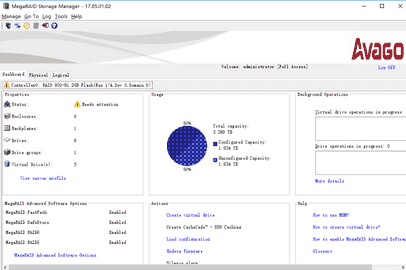

The lack of redundancy with a JBOD arrangement uses all available drive capacity but puts data at higher risk of corruption.

While JBOD can be less expensive than RAID, it has few other advantages. JBOD does not use striping or parity, but it can treat multiple disks as one entity and combine their capacity. JBOD, or just a bunch of disks, may also be considered as an alternative to RAID 10. This can help protect against two simultaneous disk failures, but the compute power needed to make two parity calculations for every write operation slows RAID 6 significantly. RAID 6 stripes data and calculates parity two times, storing these results in different areas of the disk. The heavier lifting required by RAID 5, 50 and 6 could therefore result in a higher risk of failure and data loss. However, when rebuilding with RAID 10, only the surviving mirror of all the drives is read, while non-mirroring levels require all remaining drives to be read. This drive capacity penalty is much higher than RAID levels that don't use mirroring.īecause of this capacity penalty, levels such as RAID 5, 50 (5+0) and 6 may be considered as alternatives. The 100% storage capacity overhead that disk mirroring requires means if 20 TB is installed in a RAID 10 environment, only 10 TB of disk space is available for live data, with the other 10 TB reserved for the mirror copy. How RAID 10 mirrors two drives and uses them to create a striped setĪccording to manufacturer specifications and independent benchmarks, RAID 10 provides lower latency and superior throughput compared with all other RAID levels, except for RAID 0. During the rebuild process, data in the RAID system will not be available. If there is a lot of data on the drive array supporting parity RAID, the rebuild can take hours - or even days. With parity, a failed drive is rebuilt using the data from the surviving drives in the set along with the parity information. Other RAID levels use a parity-based scheme to protect the data. The switch to the mirrored drives is nearly instantaneous, so any disruptions to normal operations will be limited.
LSI MEGARAID STORAGE MANAGER REPLACE FAILED DRIVE FULL
When an original drive or set of drives fails, the user simply switches to the mirrored devices to regain full access to the data. It creates a full, intact copy of all active data. Mirroring is the simplest way to ensure data protection. Disk mirroring's data protection advantages While both RAID levels use the same number of drives, they are not synonymous. RAID 0+1 creates two stripe sets and then mirrors them. RAID 1+0 mirrors two drives together and then creates a striped set with the pair. While RAID 1+0 is similar to RAID 0+1, the reversed order of the numbers indicates the two RAID levels are layered in the opposite order. The two-number format of RAID 10/1+0 is known as a nested RAID configuration because it combines two RAID levels to enhance performance. That 100% storage capacity overhead may be overkill for small businesses and consumer use. However, the four-disk minimum requirement makes RAID 10 a costly choice for smaller computing environments. The high performance of RAID 10, and its ability to speed up both write and read activities, makes it suited to frequently used, mission-critical database servers. It's also good for organizations that require little to no downtime. It is the a good option for I/O-intensive applications - including email, web servers, databases and operations that require high disk performance. RAID 10 provides data redundancy and improves performance. That way multiple read/write heads on the drives can write or access portions of data simultaneously, thus speeding up overall processing. It does that by spreading the data out across two or more drives. RAID 0 doesn't provide any data protection its sole purpose is to enhance drive access performance. Because it makes a full duplicate of the data, RAID 1 requires twice as much storage capacity as the original data. Data is fully protected as the mirror copy is available if the originating drive is disabled or unavailable. A RAID 1 configuration copies data from one drive to another, mirroring and duplicating data to provide improved fault tolerance and data protection. RAID, which stands for redundant array of independent disks, comes in several different configurations. If two disks in the same mirrored pair fail, all data will be lost because there is no parity in the striped sets. As long as one disk in each mirrored pair is functional, data can be retrieved. It requires a minimum of four disks and stripes data across mirrored pairs. RAID 10, also known as RAID 1+0, is a RAID configuration that combines disk mirroring and disk striping to protect data.


 0 kommentar(er)
0 kommentar(er)
